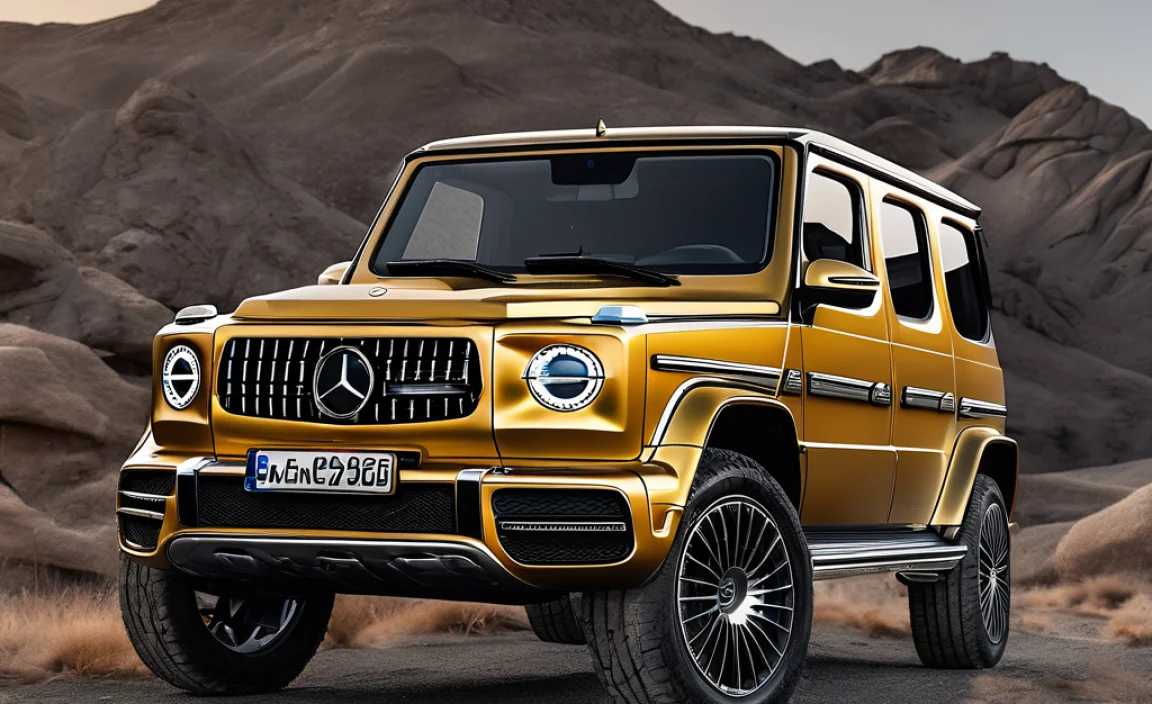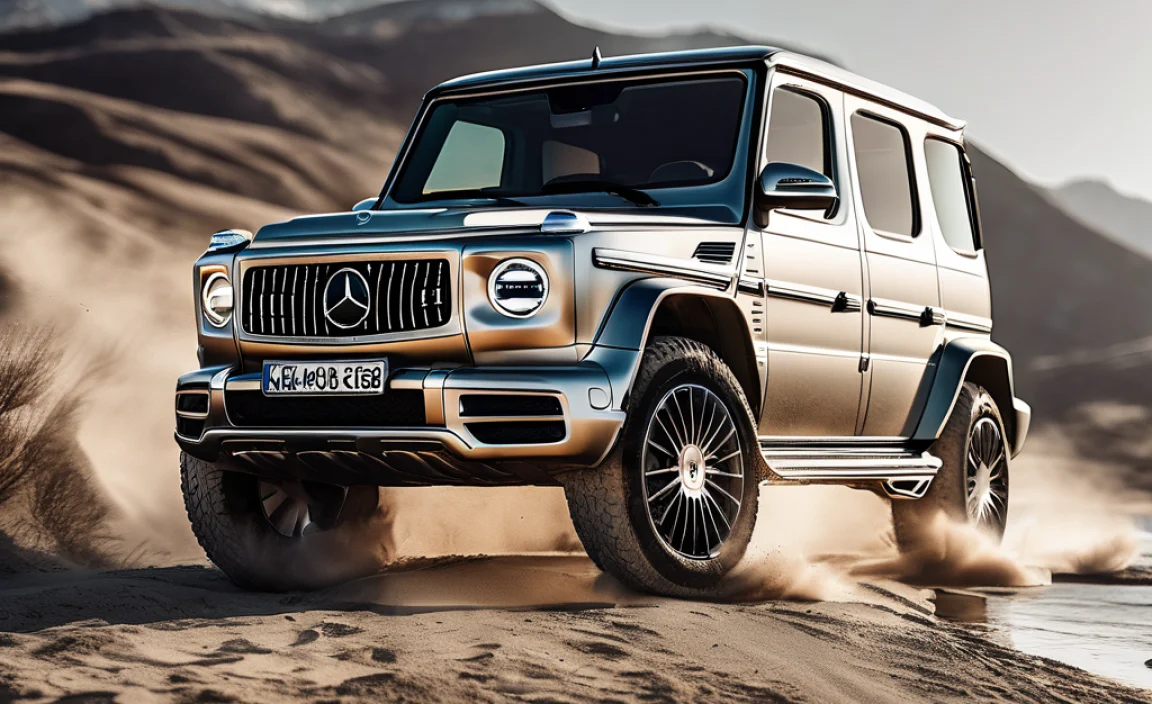When you think of the Mercedes G-Class, you probably picture a rugged legend—part luxury SUV, part mountain goat. But now, something groundbreaking is happening. Mercedes-Benz has officially filed a design patent for an all-electric G-Class, signaling that even icons can evolve. This isn’t just a new electric model; it’s a bold statement blending legacy, EQ technology, and modern sustainability. With increasing global demand for electric vehicles, the move is more than timely, it’s strategic.
Mercedes files patent for electric G-Class! So, what does this patent filing really mean for the future of off-roading, luxury, and the automotive industry at large? Let’s dive into the electrified world of the future G-Wagon.
The Evolution Of The G-Class

Let’s be real—if you’ve ever seen a Mercedes G-Class in traffic, you’ve probably done a double take. It’s more than a car. It’s a symbol. A boxy, commanding beast that’s somehow equally at home on rocky trails and red carpets. But what makes the G-Wagon so iconic?
Its roots go way back. The G-Class started life in the late 1970s, co-developed as a rugged military vehicle. Through decades, it evolved without losing that unmistakable ladder frame chassis. While most SUVs went soft, the G-Class kept its edge. But here’s the twist: now, Mercedes is giving it an electric heart.
Historical Background Of The G-Class

Originally built under a joint venture between Daimler-Benz and Steyr-Daimler-Puch, the G-Class was never supposed to be glamorous. Its purpose? Military reliability and off-road prowess. Fast forward a few decades and you’ve got a luxury icon adored by celebrities and adventurers alike.
But the world’s changing. With internal combustion engines facing tighter regulations and environmental concerns growing louder, even legends like the G-Class must evolve.
Transition To Electric Vehicles

Electric vehicles (EVs) aren’t just a passing trend—they’re the future. Mercedes-Benz knows this. Under the leadership of CEO Ola Källenius, the company is aggressively pushing EQ technology. The electric G-Class isn’t just a passion project. It’s a calculated move to blend heritage with sustainability.
This isn’t a switch-flip moment either. Mercedes has been building toward this, leveraging the company’s new EVA architecture (Electric Vehicle Architecture) to create powerful, efficient, and stylish electric models across their lineup.
Strategic Role Of Design Patents

When Mercedes-Benz files a patent application, it’s never just paperwork—it’s a signal. With the Electric G-Class now officially entering the patent pipeline, Mercedes is making it clear: the future of luxury off-roading is electric. This move blends the raw torque and rugged appeal of the original G-Wagon with cutting-edge EQ technology, modern sustainable materials, and the company’s new EVA architecture.
What it really means is that Mercedes is preparing to redefine what power, performance, and prestige look like in the EV era. It’s not abandoning its roots—just reimagining them with electric motors, digital features, and a bold stance in the evolving automotive industry. The G-Class isn’t going away. It’s going electric—and that’s a game-changer.
So why the buzz about Mercedes’ recent patent filing for an electric G-Class? Well, design patents are more than paperwork—they’re a sneak peek into the future.
What Are Design Patents?
Think of design patents like fashion copyrights. They don’t cover what a car can do (that’s utility patents), but rather how it looks. And in the automotive industry, where brand identity is everything, that matters big time.
Importance Of Design Patents In Automotive Industry
Design isn’t just skin-deep. It helps buyers emotionally connect with a model. Patents protect that emotional signature from being cloned. In the case of the Electric G Class, design patents ensure no one else can mimic its silhouette, accessories, or visual trademarks.
How Patents Protect Mercedes’ Unique Design Elements
Mercedes is safeguarding their investment. By securing trademark applications and design patents, they protect everything from the shape of the grille to the placement of charging ports. It’s about intellectual property, but also about preserving what makes a G-Class a G-Class.
Integration Of Sustainable And Digital Design

Mercedes isn’t just electrifying the G-Class—they’re rethinking how it’s built and experienced.
Sustainable Materials In Design
We’re talking recycled metals, vegan leathers, and smart material choices that echo the values of Gen Z and younger millennial buyers. Sustainability isn’t optional anymore. It’s a feature people actively look for.
Incorporating Digital Technologies
From interactive ambient lighting to intuitive haptic controls, digital tech is central to the new driving experience. EQ technology allows for seamless integration between the car and the driver’s lifestyle—syncing devices, adjusting preferences, and even learning habits over time.
Impact On User Experience And Interaction
An electric model like the G-Class EV offers a smoother, quieter ride without losing the torque and power the original is known for. Imagine rock crawling in near silence. It’s a strange but thrilling contrast.
Aligning With Emerging Trends
Mercedes isn’t just reacting to the market—they’re shaping it.
The Rise Of Electric Vehicles
EV demand is skyrocketing. Governments are offering incentives. Charging infrastructure is expanding. And parents teaching their kids to drive might soon only have electric options.
Advances In Autonomous Driving
The electric G-Class is expected to feature next-gen driver assistance systems. We’re talking semi-autonomous features that make highway cruising safer and less stressful, using methods that rely on radar, cameras, and AI learning models.
Reimagining Interior Spaces
EVs free up cabin space. No bulky transmission tunnels mean more room for creativity. The electric G-Class could offer lounge-style seating, ambient wellness lighting, and smart surfaces that display live weather or your favorite playlist.
Securing Competitive Advantage
Every patent filing adds a layer of protection—not just against lawsuits but against creative theft.
Safeguarding Innovation Against Imitation
Let’s face it, the moment something iconic gets popular, someone tries to copy it. Mercedes’ legal filings, including trademark applications and intellectual property claims, are preemptive strikes to keep copycats at bay.
Enhancing Brand Longevity And Integrity
In a world where quality, method, and design mean everything, staying original is key. These filings protect that originality, helping Mercedes maintain its premium image.
Global Market Impact
The implications go far beyond Germany.
Future Outlook For Electric G-Class
Markets like the U.S., China, and the UAE are prime targets. The G-Class already has massive fanbases there. Now imagine the appeal when it comes with a zero-emissions badge.
Potential Challenges In The Market
The challenge? Price, charging network gaps in rural areas, and skepticism from off-road purists. Converting tradition into technology isn’t easy.
Opportunities For Growth And Expansion
Still, the potential is enormous. From auto guide reviews to eco-luxury influencers on TikTok, the buzz is real. Mercedes can tap into both old-school loyalty and new-age green trends.
The Continuous Evolution Of Brand Strategy
Mercedes is playing the long game.
Their electric G-Class isn’t a gimmick—it’s a bold chapter in their story. They’re not just launching a car; they’re reimagining what luxury off-roading means in the 21st century. It’s a fusion of brawn, brains, and batteries.
And as more details emerge from their patent application, the message is clear: Mercedes isn’t waiting for the future. They’re building it.
Conclusion
In the end, the electric G-Class isn’t just another model—it’s a statement. By filing a design patent, Mercedes-Benz is preserving the G-Wagon’s bold character while future-proofing it for a generation that values both power and planet. It’s a perfect blend of heritage and innovation, where torque meets tech, and design meets sustainability. As the automotive industry moves swiftly toward electrification, Mercedes isn’t watching from the sidelines—it’s leading the charge. Whether you’re an off-road purist, a tech enthusiast, or just someone who admires bold moves, this electrified icon is one to watch. The road ahead is quiet—but it’s powerful.
FAQs
Q: What Does Mercedes’ Electric G-Class Patent Filing Mean?
A: It means Mercedes is officially protecting the unique design of its upcoming electric G-Wagon, signaling serious intent to electrify one of its most iconic models.
Q: Will The Electric G-Class Keep Its Original Design?
A: Yes, Mercedes aims to retain the G-Class’s signature boxy shape while integrating modern electric components and digital features.
Q: What Technology Will Power The Electric G-Class?
A: The vehicle is expected to use Mercedes’ EVA platform, high-capacity batteries, and advanced electric motors to deliver serious off-road performance.
Q: Is Mercedes Really Committed To Electric Off-Roaders?
A: Absolutely. CEO Ola Källenius has made it clear that electrification, including for rugged models like the G-Class, is central to the brand’s future.
Q: When Will The Electric G-Class Be Available For Sale?
A: While no official release date has been confirmed, the recent patent filing suggests that development is well underway, and production may follow soon.
Q: How Does This Impact The Automotive Industry?
A: It raises the bar for luxury EVs, proving that even heritage-rich models like the G-Class can evolve with sustainability and EQ technology at the core.
Q: Will The Electric G-Class Still Use A Ladder Frame Chassis?
A: Yes, early reports and filings suggest that Mercedes intends to retain the rugged ladder frame chassis, a key part of the G-Class’s identity.